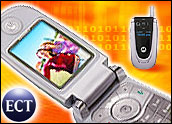
Japanese mobile giant NTT DoCoMo and U.S.-based Motorola are teaming to develop a multimodal handset targeted at Japanese business users who must use the mobile phones in other parts of the world.
The move highlights the realization by many large mobile carriers and handset makers, including Verizon and Qualcomm, that to compete on the global scale, they must offer multimodal phones that work with the different wireless technologies and standards of the world.
The NTT DoCoMo-Motorola device, which takes advantage of so-called third generation or “3G” high-speed technologies and is scheduled for commercialization in about a year, will be compatible with GSM/GPRS technology used outside Japan and with the FOMA technology that is used in Japan.
“Motorola is proud to bring our 3G expertise to this partnership with NTT DoCoMo,” said Motorola PCS North Asia Vice President and General Manager Patrick Kung in a statement. “This device perfectly embodies our mission to enable users to have a personal hub of communications in the palm of their hand.”
Business Benefits
NTT DoCoMo, the biggest Japanese handset carrier, said the multimodal phone, unlike existing i-mode phones, will be able to access the Internet through any available Internet connection and will be able to display standard Web pages.
NTT DoCoMo executive vice president Kei-ichi Enoki said the handset meets the needs of business users and differs from a device for consumers.
“In particular, the phone can connect to public, high-speed wireless LAN networks to browse the Internet and receive e-mail,” he said in a statement. “It also opens a variety of attached documents in their original formats and even works on mobile networks outside Japan.”
Enoki said NTT DoCoMo believes a new market of business travelers will join the existing i-mode market in future growth with the new handset, which also will be compatible with public wireless LAN services from DoCoMo and others.
Motorola Meaning
Yankee Group analyst John Jackson said the deal on the device is not surprising, given that NTT DoCoMo recently announced a US$340 million investment to develop multimode handsets.
For Motorola, the company is gaining traction in the Japanese market with DoCoMo and “taking a lead” in its push for wideband, global coverage, Jackson told TechNewsWorld.
Motorola’s Kung said the new FOMA handset would help business users more efficiently multitask, especially when traveling outside Japan because they can use the phone and all of its features anywhere in the world.
Small Market, Big World
Jackson said the new device from DoCoMo and Motorola — which can be used to view e-mail attachments and will support Bluetooth connectivity — will not reach a very large audience.
“This is a phone that will capture a small but highly lucrative segment of Japanese business traveler who has not been able to take their phone with them,” Jackson said.
Although carriers might be more interested in more widespread adoption, they all are realizing the need to support multiple standards and modes.
“It’s an indication of a recognition on DoCoMo’s part that it needs to be globally standards compliant,” Jackson said, adding that Verizon and Qualcomm are among others with similar strategies. “They’re recognizing that multimodality is important and incorporating that significantly into their roadmap strategies going forward.”











































